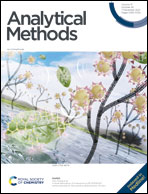Volatile atmospheric pressure chemical ionisation mass spectrometry headspace analysis of E. coli and S. aureus†
Abstract
Identifying the characteristics of bacterial species can improve treatment outcomes and mass spectrometry methods have been shown to be capable of identifying biomarkers of bacterial species. This study is the first to use volatile atmospheric pressure chemical ionisation mass spectrometry to directly and non-invasively analyse the headspace of E. coli and S. aureus bacterial cultures, enabling major biological classification at species level (Gram negative/positive respectively). Four different protocols were used to collect data, three utilising discrete 5 min samples taken between 2 and 96 h after inoculation and one method employing 24 h continuous sampling. Characteristic marker ions were found for both E. coli and S. aureus. A model to distinguish between sample types was able to correctly identify the bacteria samples after sufficient growth (24–48 h), with similar results obtained across different sampling methods. This demonstrates that this is a robust method to analyse and classify bacterial cultures accurately and within a relevant time frame, offering a promising technique for both clinical and research applications.



 Please wait while we load your content...
Please wait while we load your content...